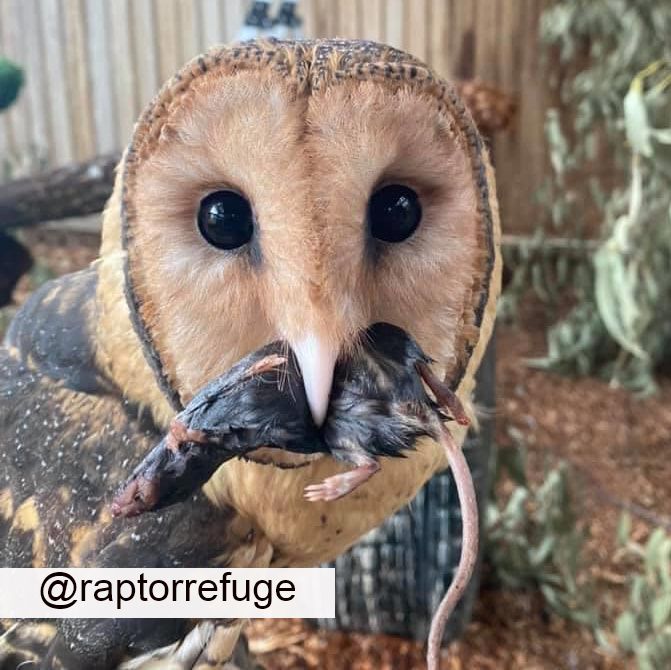BIRD-FRIENDLY RODENT CONTROL : Dealing with uninvited guests
Birdlife Australia
Unwelcome visits from rats or mice can make us reach straight for the rodent bait. While we ensure baits are put out of reach of children, pets and other animals, we rarely think about where rodents go after they have eaten baits. In fact, we probably try and think about it as little as possible.
The most commonly used rodent poisons are anticoagulant rodenticides (ARs). These act as blood thinners, so rats and mice can consume a lethal dose but not feel sick until later.
Newer ARs, called second generation anticoagulant rodenticides (SGARs), are powerful enough that a single feed can be lethal. But because of the time lag between taking a bait and feeling the effects, rodents can consume a more-than-lethal dose and still be wandering around - like walking time bombs.
Predators that naturally eat rodents, like owls and birds of prey, can then easily consume multiple poisoned rodents, in turn becoming poisoned themselves. SGARs don’t break down quickly – some can stay in tissues and organs for months, even years. Unfortunately this just makes it easier for these bigger animals to get a lethal dose of toxins.
Newer ARs, called second generation anticoagulant rodenticides (SGARs), are powerful enough that a single feed can be lethal. But because of the time lag between taking a bait and feeling the effects, rodents can consume a more-than-lethal dose and still be wandering around - like walking time bombs.
Predators that naturally eat rodents, like owls and birds of prey, can then easily consume multiple poisoned rodents, in turn becoming poisoned themselves. SGARs don’t break down quickly – some can stay in tissues and organs for months, even years. Unfortunately this just makes it easier for these bigger animals to get a lethal dose of toxins.
The evidence against SGARs
The link between SGARs and Australian birds was found when researching declining Southern Boobook populations. Almost 73% of samples tested from boobooks in southwest WA had detectable exposure to ARs. Of even greater concern, about 18% of all the boobooks tested had levels of exposure that were high enough to kill them directly. Almost all the toxins were identified as SGARs. These were found in both urban and rural birds.
While other factors may also be impacting the decline of these small predators, the potential impact of anticoagulant rodenticides cannot be ignored.
The key differences between earlier, first generation anticoagulant rodenticides (FGARs) and SGARs is how long the toxins remain in the body. FGARs break down quicker, and so there is less chance of larger animals being poisoned. SGARs can stay in body tissues for months or even years. Yet Australia has little regulation on their use - SGARs can be easily purchased in hardware and grocery stores across the country.
How do I tell which is which?
The flashy packaging of rodent baits can make it difficult to tell exactly what they contain. However, the label will state the “Active Constituents”, so look there for the FGAR compounds that are less harmful such as Warfarin or Coumatetralyl. If the bait contains more harmful SGARs like Brodifacoum, B r o m a d i o l o n e , Difenacoum, Difethialone, or Flocoumafen, leave it on the shelf.
Globally SGARs have been responsible for declines in many carnivorous mammals and birds. Here in Australia it is not just Boobooks or other owls that are at risk. Other predatory and scavenging birds are also likely to be affected – from our eagles and falcons to our kookaburras, magpies, ravens, and currawongs. Native mammals like quolls and large reptiles like goannas and pythons are also likely to be affected.
How can I help?
It is easy to minimise your impact. Check out the handy guide at birdlife.org.
While other factors may also be impacting the decline of these small predators, the potential impact of anticoagulant rodenticides cannot be ignored.
The key differences between earlier, first generation anticoagulant rodenticides (FGARs) and SGARs is how long the toxins remain in the body. FGARs break down quicker, and so there is less chance of larger animals being poisoned. SGARs can stay in body tissues for months or even years. Yet Australia has little regulation on their use - SGARs can be easily purchased in hardware and grocery stores across the country.
How do I tell which is which?
The flashy packaging of rodent baits can make it difficult to tell exactly what they contain. However, the label will state the “Active Constituents”, so look there for the FGAR compounds that are less harmful such as Warfarin or Coumatetralyl. If the bait contains more harmful SGARs like Brodifacoum, B r o m a d i o l o n e , Difenacoum, Difethialone, or Flocoumafen, leave it on the shelf.
Globally SGARs have been responsible for declines in many carnivorous mammals and birds. Here in Australia it is not just Boobooks or other owls that are at risk. Other predatory and scavenging birds are also likely to be affected – from our eagles and falcons to our kookaburras, magpies, ravens, and currawongs. Native mammals like quolls and large reptiles like goannas and pythons are also likely to be affected.
How can I help?
It is easy to minimise your impact. Check out the handy guide at birdlife.org.

